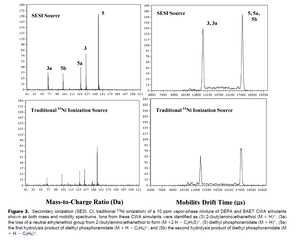Secondary Ionization of Chemical Warfare Agent Simulants: Atmospheric Pressure Ion Mobility Time-of-Flight Mass Spectrometry
W. E. Steiner, B. H. Clowers, P. E. Haigh, and H. H. Hill
Abstract: For the first time, the use of a traditional ionization source for ion mobility spectrometry (radioactive nickel (63Ni) beta emission ionization) and three alternative ionization sources (electrospray ionization (ESI), secondary electrospray ionization (SESI), and electrical discharge (corona) ionization (CI)) were employed with an atmospheric pressure ion mobility orthogonal reflector time-of-flight mass spectrometer (IM(tof)MS) to detect chemical warfare agent (CWA) simulants from both aqueous- and gas-phase samples.
For liquid-phase samples, ESI was used as the sample introduction and ionization method. For the secondary ionization (SESI, CI, and traditional 63Ni ionization) of vapor-phase samples, two modes of sample volatilization (heated capillary and thermal desorption chamber) were investigated. Simulant reference materials, which closely mimic the characteristic chemical structures of CWA as defined and described by Schedule 1, 2, or 3 of the Chemical Warfare Convention treaty verification, were used in this study. A mixture of four G/V-type nerve simulants (dimethyl methylphosphonate, pinacolyl methylphosphonate, diethyl phosphoramidate, and 2-(butylamino)ethanethiol) and one S-type vesicant simulant (2- chloroethyl ethyl sulfide) were found in each case (sample ionization and introduction methods) to be clearly resolved using the IM(tof)MS method.
In many cases, reduced mobility constants (Ko) were determined for the first time. Ion mobility drift times, flight times, relative signal intensities, and fragmentation product signatures for each of the CWA simulants are reported for each of the methods investigated.


